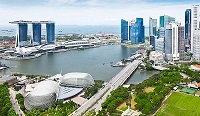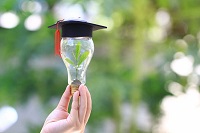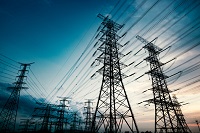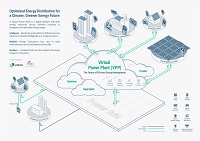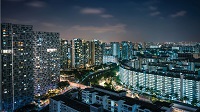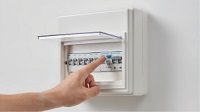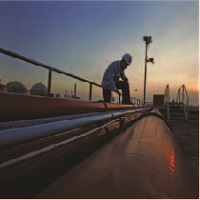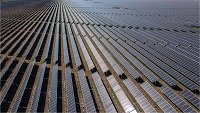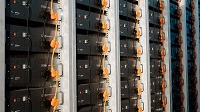For more information, please refer to:
Media Releases
25 Oct 2021
- Climate change is a global existential threat and Singapore is doing its part to reduce emissions for a more sustainable future. Our Long-Term Low-Emissions Development Strategy (LEDS) aspires to halve emissions from its peak to 33 MtCO2e (metric tonnes of carbon dioxide equivalent) by 2050, with a view to achieving net zero as soon as viable in the second half of the century.
- The power sector has a key part to play as it accounts for about 40% of Singapore’s carbon emissions[1]. We need to significantly reduce the power sector’s emissions, while ensuring that the power system remains secure, reliable and sustainable. Singapore is therefore harnessing four Switches – natural gas, solar, regional power grids and low-carbon alternatives – to transform its energy supply, while promoting energy efficiency to reduce demand.
- As Singapore transitions towards cleaner energy sources, reliable and sufficient energy sources are needed to ensure supply reliability. Natural gas will continue to be a dominant fuel for Singapore’s electricity generation even as we scale up the other 3 Switches. EMA will continue to diversify our natural gas sources and work with the power generation companies to improve the efficiency of their power plants.
- Solar remains the most promising renewable energy source in the near term for Singapore. Today, over 500 megawatt-peak (MWp) of solar has been installed[2] and we are on track to achieving our solar panel deployment target of at least 2 gigawatt-peak (GWp) by 2030 (equivalent to powering 350,000 households a year). Conventional rooftop solar has been complemented with innovative ways of deploying solar photovoltaic systems on spaces such as water bodies, temporary vacant land or sheltered walkways, making Singapore one of the most solar dense cities in the world. To manage the intermittent nature of solar and ensure grid resilience, we are planning to deploy at least 200 megawatts (MW) of energy storage systems (ESS) beyond 2025.
- Nonetheless, there are still limitations to the amount of solar energy that we can harness due to Singapore’s limited land area. Even as we work towards achieving our 2030 solar target of 2GWp, it will constitute only around 3% of the country’s total electricity demand in 2030.
- To overcome our land constraints, Singapore is tapping on regional power grids to access cleaner energy sources beyond its borders. Regional power grids can help accelerate the development of renewable energy projects in the region, bringing economic growth and increasing access to renewable energy. Electricity imports will also help us to diversify our energy sources away from natural gas and improve our energy resilience.
- Singapore is planning to import up to 4 gigawatts (GW) of low-carbon electricity by 2035, which is expected to make up around 30% of Singapore’s electricity supply in 2035. This will be done through a competitive Request for Proposal (RFP) process. Steps will also be taken to maintain our energy security, such as diversifying our import sources and ensuring back-up supply is in place to mitigate supply disruptions.
- To pave the way for these electricity imports, EMA has been working with various partners on electricity import trials. These trials will allow us to assess and refine the technical and regulatory frameworks for importing electricity. They include a trial to import 100MW of electricity from Peninsula Malaysia, as well as a pilot to import 100MW of solar-generated electricity from Pulau Bulan, Indonesia. Singapore is also a part of the Lao PDR-Thailand-Malaysia-Singapore Power Integration Project (LTMS-PIP), which facilitates cross-border power trade among the four countries.
- Singapore is exploring emerging low-carbon technologies such as hydrogen and carbon capture, utilisation and storage (CCUS) that can help reduce Singapore's carbon footprint in the longer term. While such technologies are nascent, EMA is taking active steps including investing in R&D through the Low-Carbon Energy Research (LCER) Funding Initiative to improve the technical and economic viability of implementing low-carbon technologies such as hydrogen and CCUS.
- Advances in geothermal technology have also opened up the opportunity for us to consider the prospect of tapping on this energy source for power generation. For instance, EMA is working closely with Nanyang Technological University, and various ministries and agencies including the Ministry of Trade and Industry and the National Climate Change Secretariat to conduct studies to determine the geothermal resource potential in Singapore.
- Besides transforming the way we produce energy, managing our energy demand is also key to achieving a more sustainable future. With the economy recovering from the pandemic and as energy demand grows with increasing electrification, demand management will be a key pillar in supporting the energy transition. EMA will continue to encourage energy efficiency in the industry and households, and is concurrently developing other demand management initiatives. Together, everyone will have to play their part by conserving energy and supporting the greener energy transition for a more sustainable future.
Four Supply Switches for Power Sector Decarbonisation
A. Natural Gas
B. Solar
C. Regional Power Grids
D. Emerging Low-Carbon Technologies
Promoting Energy Efficiency to Manage Demand
[1] Source: National Climate Change Secretariat
[2] Figure accurate as of Q2 2021
